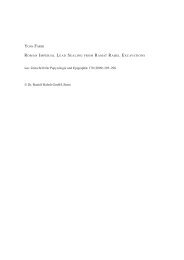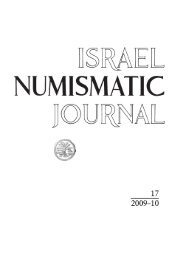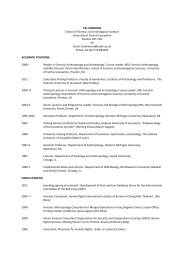Israel Numismatic Research - Institute of Archaeology
Israel Numismatic Research - Institute of Archaeology
Israel Numismatic Research - Institute of Archaeology
Create successful ePaper yourself
Turn your PDF publications into a flip-book with our unique Google optimized e-Paper software.
SILVER-PLATED SAMARIAN COIN FROM TEL DOR<br />
Both depict the Persian king, kneeling right and drawing his bow, on one side <strong>of</strong><br />
the coin. The other side <strong>of</strong> the Ḥorbat ‛Eleq coin has a war galley and the other<br />
side <strong>of</strong> the Jerusalem coin is obliterated. These two coins may be Samarian (and<br />
see Meshorer and Qedar 1999:101–103, Nos. 97, 105 and 197 for this type <strong>of</strong><br />
Persian king) although it is also possible that they are Sidonian issues. 20<br />
Fig. 5. Samarian(?) coin from Jerusalem (scale 3:1)<br />
Obv. Obliterated<br />
Rev. Persian king kneeling to l. and drawing bow.<br />
š, 0.16 g, 6–7 mm.<br />
It has been suggested that Samarian coins circulated mostly in Samaria (Gitler<br />
and Tal 2006b:57). The find <strong>of</strong> the “drachm” at Tel Dor might point that Samarian<br />
coins circulated also further north and along the coast. These coins may have also<br />
circulated in Judea, if the quarter “obol” from Jerusalem is indeed Samarian.<br />
As noted above, the coin from Dor is silver-plated. 21 Silver-plated coins are<br />
known in Samaria (Meshorer and Qedar 1991:67), Philistia, 22 and Phoenicia<br />
(BMC Phoen.:3, No. 9, pp. 229–232, Nos. 11–12, 18, 33, 38bis, 41; Qedar<br />
2000–2002:10–14). These are usually large denominations. Two explanations are<br />
given for the appearance <strong>of</strong> silver-plated coins. These coins may be <strong>of</strong>ficial silverplated<br />
issues, coined in periods <strong>of</strong> financial crisis, or they may be fraudulent<br />
and was identified by Rachel Barkay. I wish to thank her and Shimon Gibson for<br />
permission to include this information here and to Donald T. Ariel for locating the<br />
coin in the IAA collection.<br />
20 For similar Sidonian types see, for example, BMC Phoen.:142, Nos. 14–16; Lambert<br />
1932:7, Nos. 36–38; Meshorer and Qedar 1991, Nos. 195–200; Elayi and Elayi 2004:<br />
Nos. 1219, 2596–2606.<br />
21 As far as I know, the question <strong>of</strong> silver-plated coins in the Persian period has not<br />
yet been fully studied. For general information concerning silver-plating <strong>of</strong> coins see<br />
Zwicker, Oddy and La Niece 1993.<br />
22 Several silver-plated Athenian and Athenian-styled “tetradrachms” <strong>of</strong> the fifth and<br />
fourth centuries BCE appear in Gitler and Tal (2006a:27–30, table 2.1). Two copper<br />
cores <strong>of</strong> plated Philistian “drachms” and another silver-plated “drachm” are mentioned<br />
by Gitler and Tal (2006a:330; 2006b:60 n. 44), one <strong>of</strong> Gaza (Gitler and Tal 2006a:132,<br />
VI. Gaza. 1D [variant] c) and the other two are classified as Athenian-styled (Gitler<br />
and Tal 2006a:184, XIII. Obverse Athenian-styled. 16D). For a silver-plated “obol”<br />
see Farhi 2009:238, No. 3.<br />
27






